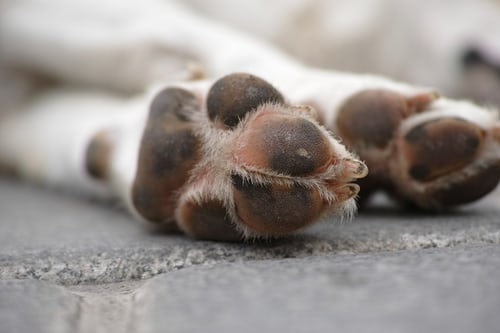A paw pad tear is a common injury in dogs. It can occur from stepping on foreign objects like glass, rocks, or metal, and in the winter, ice is often the cause.
Along with four toe pads, dogs have a larger pad in the center of their paws, as well as carpal pads on both front legs. These carpal pads are located right where wrists would be, and some dogs have them on their back legs as well. They primarily serve as shock absorbers and for braking at high speeds. Since these pads do not make contact with the ground at all times, torn carpal pads tend to be less common, occurring more in highly active dogs.
Preventing Paw Injuries
- Be aware of your surroundings, always keeping an eye out for any glass or sharp objects.
- Never walk your dog on hot pavement in the summer.
- In the winter, dog boots can protect your dog’s feet from extreme temperatures, areas with sharp ice, and roads that have been treated with salt and other surface chemicals.
- A pet first aid kit is crucial, especially if you and your dog do a lot of hiking and outdoor activities.
- Paw tears are very painful and your dog may cry out and even try to stop you from tending to the wound, so having a muzzle on hand is a good idea.
Taking precautions helps, but accidents happen, and when your dog has cut his foot and has a torn or ripped pad, you need to deal with it immediately to prevent it from worsening.

What to Do If Your Dog Tears a Paw Pad
To assess and clean the wound, first flush it with warm water.
Use tweezers to gently remove any debris or foreign objects that are not lodged deep in the pad. If it is not easily removed with tweezers or appears stuck, do not force it out and seek veterinary care. Attempting to remove an object forcefully can cause further damage.
Control any bleeding by applying pressure with a clean towel. If the bleeding does not stop within 10-15 minutes, you have an emergency situation and need to get your dog to a vet as soon as possible.
Bandaging The Wound
If necessary, rinse the area again with warm water and pat dry.
To avoid dog paw infection apply an antimicrobial wound spray to disinfect the cut and allow it to dry. Please note that antibiotic ointments may be used for minor cuts and scrapes but they are not recommended for deeper wounds.
Once the wound spray has dried, place a non-stick sterile pad over the wound and wrap with nonstick gauze. Use medical tape to keep this in place, then wrap your dog’s foot with an elastic bandage keeping it snug, but not too tight. Wrap all the way up to the wrist or hock area to prevent the bandage from falling off.
Once fully wrapped, to avoid potentially cutting off circulation to the foot, test for tightness. If you can place 2 fingers under the bandage, it is not too tight.
Paw bandages should be changed daily and wound spray should be reapplied. In addition to helping to prevent infection, antimicrobial wound spray reduces pain, soothes the injury, and promotes healing.
To help keep the bandage clean you can put an old sock over it.
Keep your dog as calm as possible to allow time for the paw tear to heal. Any activity can easily re-open the wound, causing it to start bleeding again.
When taking your dog outside, you need to make sure the bandage does not get wet. There are medical waterproof boots available, or you can just put a plastic bag over the foot and secure it with tape or an elastic.

What About a Paw Pad Injury That Does Not Bleed?
Some foot injuries may not be deep enough to bleed a lot, or may bleed a small amount. If we don’t see bloody footprints, we may be completely unaware an injury has even occurred.
Here are some signs that your dog may be experiencing a foot tear injury:
- Limping or favoring one foot.
- Whimpering, whining or panting.
- Licking their paw pad excessively.
- Low energy and lethargy.
- Disinterest in activities that they normally enjoy.
How Long Will It Take to Heal?
Because these types of injuries usually can’t be stitched up, they can be difficult to treat and tend to take a long time to heal.
Dog paw cut healing time depends on several factors.
- How severe the original injury was and how large the size of the wound.
- The level of care you are able to provide your dog, including changing the bandage and reapplying wound spray on a daily basis.
- How well you are able to monitor your dog during their recovery to prevent them from removing the bandage, or from becoming too active and potentially re-injuring the wound.

There are preventative measures you can take; however, paw pad tears and foot injuries do happen sometimes, and knowing how to deal with them can ensure a speedy recovery for your dog, and get them back on their feet as quickly as possible.




